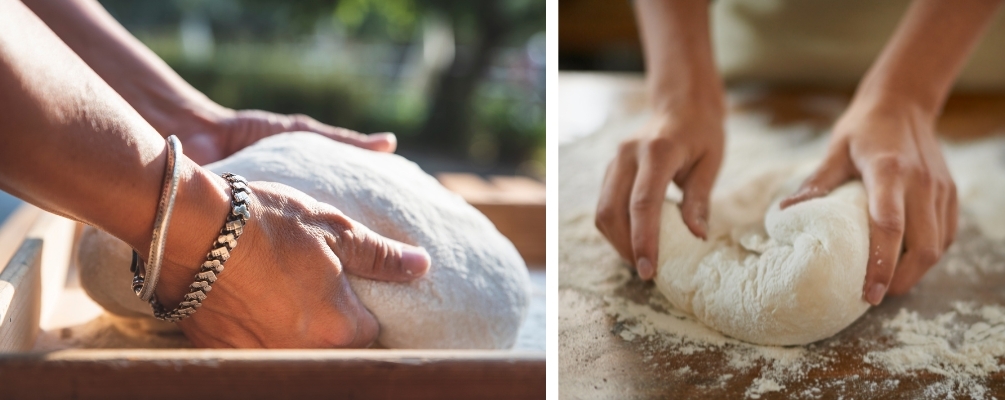Ever started baking only to realise you're out of the flour you need? Don't panic! Whether you need to make a quick flour swap, make your own self-raising flour, or are wondering about the difference between fortified and non-fortified flours, we've got you covered. This quick guide will keep your baking (and cooking) on track – no last-minute grocery runs needed!
BAKING HACKS
How Do I Substitute All-Purpose Flour for Organic Almond Meal?
Run out of ordinary flour? Organic Almond Meal is a great alternative but does need a bit of TLC as it absorbs moisture differently. Here’s how to use it instead of wheat flour.
- Use ¼ cup less Almond Meal for every 1 cup of regular Organic Flour.
- Alternatively, add an extra egg in your recipe to help with structure.
Tip: Almond Meal works best in recipes that already contain eggs like pancakes, muffins, and cookies.
How Do I Make Plain Flour Self-Raising Flour?

If you don’t have self-raising flour on hand, make your own with this quick and easy recipe.
DIY Self-Raising Flour Recipe
For every 1 cup of plain flour, add:
- 2 teaspoons Baking Powder
- ¼ tsp salt
Mix well and use as a substitute for self-raising flour in baking.
How Do I Make Baking Powder?
Run out of Baking Powder? To make 1 teaspoon of baking powder combine 1/2 teaspoon of Cream of Tartar with 1/4 teaspoon Bi-Carb Soda. You’re welcome!
FAST FLOUR FACTS
What is All-Purpose Flour?

Organic White All-Purpose Flour is a versatile, flour that can be used for most baking and cooking needs. It sits between plain flour and baker’s flour, making it ideal for everything from flour bread to pastries.
Fact: Our All-Purpose Flour is made from Australian wheat grain, is 100% natural, not artificially enriched and is sustainably grown!
Is Corn Starch the same as Corn Flour?
While both are derived from corn, they are milled differently to produce a different finish. Corn Flour is used in baking and making lighter foods like tortillas. Organic Corn Starch is used as a thickening agent for sauces, soups, and gravies and is free additives and preservatives.
What is Gluten-Free Flour?
Gluten-free flour is made from grains, nuts, or starches that do not contain gluten and is great for those with special dietary needs. Common gluten-free flours include:
- Rice Flour (light and neutral)
- Tapioca Flour (adds chewiness)
- Besan Flour (adds protein and density)
- Teff Flour (nutty flavour & dense texture)
Tip: To add more elasticity when baking or cooking with gluten-free flours, add Xanthan Gum.

- For yeasted bread & pizza doughs – use 1 tsp Xanthan Gum per 1 cup of flour.
- For baked goods like cakes and muffins - use ¼ tsp Xanthan Gum per cup of gluten-free flour.
- For pastry (where more elasticity is required) – use ½ tsp Xanthan Gum per cup of gluten-free flour.
What is Sustainable Flour?
Sustainable Flour is flour that is grown by certified sustainable farmers who use regenerative farming methods to promote healthy soils and improve the environment. Certified sustainable farmers manage their land in an environmentally friendly way, sequestering carbon, building diversity, enriching the soil and provide an overall nutritionally superior product for you.
Baker’s Tip: Opt for Sustainable Stoneground White Baker’s Flour or Wholewheat Heritage Flour for the best rise and texture.
>>> Read about Sustainable Farming here
What’s the Difference Between Fortified and Non-Fortified Flour?
In Australia and many other countries, non-organic wheat flours intended for bread-making are required to be fortified with folic acid (vitamin B9) and thiamine (vitamin B1. Folic acid is important for the healthy development of babies, especially during early pregnancy. Organic wheat flours are exempt from this mandatory fortification, enabling them to stay true to their most natural form.





![Meet the Buckies: Grain-Free Brekky & Snacking Stars [Supplier Spotlight] Meet the Buckies: Grain-Free Brekky & Snacking Stars [Supplier Spotlight]](https://cdn11.bigcommerce.com/s-dis4vxtxtc/images/stencil/160w/uploaded_images/buckies-blog.jpg?t=1738817229)
